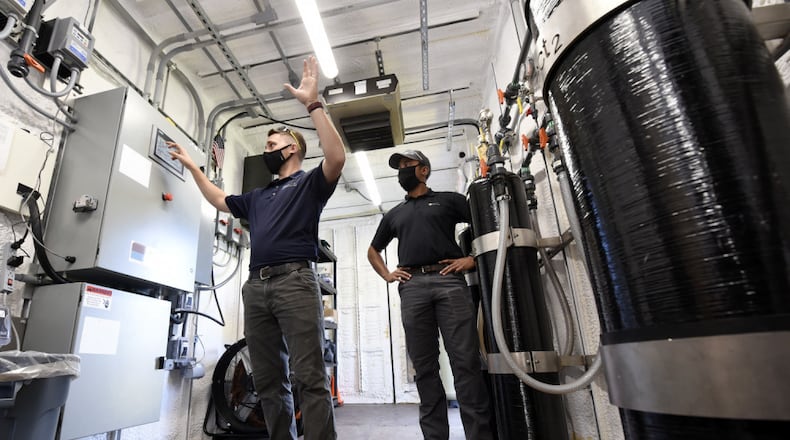“The groundwater near the base boundary is below (the Environmental Protection Agency’s action levels),” Wright-Patt officials said. “The Air Force conducts quarterly sentry well sampling to track any changing levels and regularly shares this information with the city of Dayton.”
The Ohio Environmental Protection Agency declined to confirm if the base is in compliance with environmental laws, saying it “strongly encourages and supports proactive and expeditious measures to be taken by (Wright-Patt) to ensure Dayton continues to have safe drinking water.”
A group of dangerous chemicals known as Per-and polyfluoroalkyl substances ― or PFAS ― have been flowing from the base to the city’s wellfield for years, Dayton officials said. PFAS, dubbed “forever chemicals,” have been linked to cancer, birth defects, increased cholesterol, decreased vaccine response in children and other health issues, according to the Centers for Disease Control and Prevention.
PFAS from both Areas A and B of the base has migrated to the Mad River Wellfield due to the natural flow of the water, said Mike Powell, Dayton Department of Water director. He noted that PFAS from the base is a threat to both surface water and groundwater in the wellfield.
Dayton is currently part of a class action lawsuit against PFAS manufacturers. The litigation came after the city discovered that firefighter foam it used for decades at its Firefighter Training Center, located near the Mad River Wellfield, contained PFAS. The chemicals seeped into the groundwater, and the city shut down several production wells as a precaution when monitoring wells detected PFAS, Powell said.
The city has kept the drinking water safe, Powell said, shutting down several of its production wells because of the contamination the city says is coming from the base. But Wright-Patt must take action to address the hotspots and other contaminated areas, he said. Failing to do so would cost hundreds of million of dollars in the long run to provide an alternative supply of drinking water, Powell said.
The city sent letters dated March 31 to Wright-Patt officials and the U.S. Department of Defense to inform them of its intentions to file a lawsuit within 60 days, as required by law. The city said it will not file the suit if Wright-Patt and the DoD enter into an agreement with Dayton to mitigate the PFAS problem. Dayton officials said they’ve unsuccessfully attempted over the years to get Wright-Patt to address the issue, but base officials have not taken action.
Air Force officials disagree, saying they’ve taken a proactive approach and shared information with the city. It’s also worked with the state and Dayton, according to the base news release.
Between 2015 and 2020, the Air Force collected samples and technical assessments that show PFAS concentrations at a steady state and no indication of higher concentrations migrating off-base, Wright-Patt said. In addition, more than 1 billion gallons of water above the U.S. EPA recommended action level of 70 parts per trillion have been treated, using a new $2.5 million water treatment system. A part per trillion is the equivalent of a grain of sand in an Olympic-size pool or a pinch of salt in 10 tons of potato chips.
In July 2020, the Air Force awarded a $4.3 million multiyear contract for a remedial investigation of the PFAS plume boundary. The investigation, which is a method of collecting data to determine a site’s condition, started in March, the base said.
As part of that investigation, the Air Force Civil Engineer Center sent 642 letters to property owners in the community to determine if they get their drinking water from private wells, and to get permission to sample the water. The sampling is scheduled to begin in May, base officials said.
It’s unclear if contaminated groundwater flowing from Wright-Patt to the Mad River wellfield has PFAS levels above the EPA recommended action level, said Abinash Agrawal, a groundwater remediation expert and professor at Wright State University. However, Wright-Patt’s method of treating contaminated water that it pumped from the ground is only partially effective in reducing and preventing the chemicals from spreading.
“Clearly, the pump-and-treat approach is not working well if the contaminated groundwater plume is migrating outside the WPAFB boundary and entering the Mad River wellfield,” he said.
An alternative treatment approach might be to employ an inground treatment known as PlumeStop, Agrawal said. Such a technology filters the water and prevents the PFAS from spreading for as many as 40 years
“This approach has shown success at PFAS contaminated sites in North America,” he said.
About the Author

